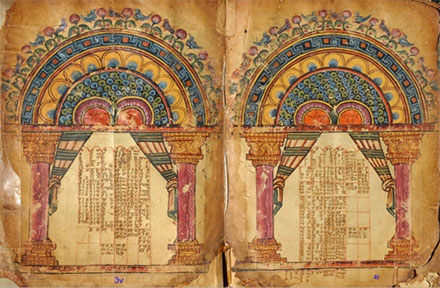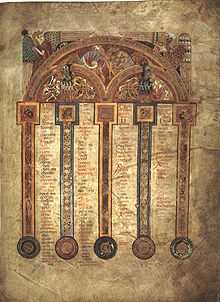169:
199:) in which the sections in question were so classified as to show at a glance where each Gospel agreed with or differed from the others. In the first nine tables he placed in parallel columns the numbers of the sections common to the four, or three, or two, evangelists; namely: (1) Matt., Mark, Luke, John; (2) Matt., Mark, Luke; (3) Matt., Luke, John; (4) Matt., Mark, John; (5) Matt., Luke; (6) Matt., Mark; (7) Matt., John; (8) Luke, Mark; (9) Luke, John. In the tenth he noted successively the sections special to each evangelist. Sections "Mark, Luke, John" and "Mark, John" are absent because no text is common to Mark and John without a parallel in at least Matthew.
181:
528:
560:
544:
47:
740:
144:, now lost, which he composed. It was traditionally believed that he divided the four Gospels into small numbered sections, which were similar in content where the narratives are parallel. He then wrote the sections of the three last Gospels, or simply the section numbers with the name of the respective
468:
The usefulness of these tables for the purpose of reference and comparison soon brought them into common use, and from the 5th century the
Ammonian sections, with references to the Eusebian tables, were indicated in the margin of the manuscripts. Opposite each section was written its number, and
469:
underneath this the number of the
Eusebian table to be consulted in order to find the parallel texts or text; a reference to the tenth table would show that this section was proper to that evangelist. These marginal notes are reproduced in several editions of
160:, namely, that he placed the parallel passages of the last three Gospels alongside the text of Matthew, and the sections traditionally credited to Ammonius are now ascribed to Eusebius, who was always credited with the final form of the tables.
54:; the tables in the book were effectively unusable, as they were over-condensed and the corresponding sections were not marked in the main text. This is either because it is unfinished, or because it was a display book not meant for study.
559:
124:
The canon tables were made to create a sense of divinity within the reader’s soul, to understand and reflect upon the various colors and patterns to achieve a higher connection with God.
527:
31:
101:) 5th to 8th century, and in Ethiopian manuscripts until the 14th and 15th centuries, with a few produced as late as the 17th century. These are usually summarized in
543:
89:
used in modern texts date only from the 13th and 16th centuries, respectively. The sections are indicated in the margin of nearly all Greek and Latin
750:
42:
gospel manuscripts of the sixth century; showing original Late
Antique arcaded forms subsequently perpetuated in Byzantine and Romanesque manuscripts
168:
802:
773:
133:
508:. In many examples the tables are the only decoration in the whole book, perhaps other than some initials. In particular, canon tables, with
516:
period, where very few manuscripts survive, and even the most decorated of those have fewer pages illuminated than was the case later.
496:
works they were placed in round-headed arcade-like frames, of which the general form remained remarkably consistent through to the
723:
678:
148:, in parallel columns opposite the corresponding sections of the Gospel of Matthew, which he had chosen as the basis of his
699:
655:
17:
86:
797:
195:
The harmony of
Ammonius suggested to Eusebius, as he says in his letter, the idea of drawing up ten tables (
637:(A Corpus of Christian Palestinian Aramaic, IIA; STYX: Groningen, 1998), pp. 94–95, 97, 139–140, 168–169.
512:, are very important for the study of the development of manuscript painting in the earliest part of the
98:
569:
are two folios from a
Byzantine manuscript of the 6th or 7th century, showing the typical arcaded frame.
792:
470:
97:, but can be also found in periphical Bible transmissions as Syriac and Christian Palestinian Aramaic (
770:
493:
180:
755:
477:
157:
771:
British
Library illuminated manuscripts - add "canon tables" to search box for many examples
580:
153:
8:
566:
509:
505:
550:
635:
The
Christian Palestinian Aramaic New Testament Version from the Early Period. Gospels
807:
719:
718:(Manuscripta Biblica Paratextus Biblici, 1) Berlin/Boston: Walter de Gruyter, 2021.
695:
674:
651:
188:
106:
39:
666:
145:
132:
Until the 19th century it was mostly believed that these divisions were devised by
777:
513:
497:
149:
118:
114:
110:
78:
35:
786:
744:
534:
51:
501:
173:
489:
90:
82:
46:
650:, ed. Roderick Grierson (New Haven: Yale University, 1993), p. 66.
152:. It is now believed that the work of Ammonius was restricted to what
646:
Carla
Zanotti-Eman, "Linear Decoration in Ethiopian Manuscripts", in
105:
at the start of the
Gospels. There are about 1165 sections: 355 for
743: This article incorporates text from a publication now in the
74:
30:
601:
An
Introduction to the New Testament Manuscripts and their Texts
121:; the numbers, however, vary slightly in different manuscripts.
671:
Manuscripts of the Greek Bible: An Introduction to Palaeography
94:
488:
The tables themselves were usually placed at the start of a
172:
An Armenian illuminated manuscript of a canon table by
27:
System of dividing the Gospels used in the Middle Ages
694:. London: The British Library. pp. 70&74.
480:was also very often reproduced before the tables.
612:Sebastian P. Brock, 'Review of Alain Desreumaux,
784:
673:, Oxford: Oxford University Press, 1991, p. 42.
176:(active 1256 - 1268) entitled Canon Table Page.
533:Eusebian tables before text of the Gospels in
633:Christa Müller-Kessler and Michael Sokoloff,
549:One of the canon tables from the 8th century
483:
748:
689:
603:, Cambridge University Press, 2008, p. 24.
447:
426:
405:
384:
302:
247:
223:
179:
167:
45:
29:
716:Die Kanontafeln des Euseb von Kaisareia
504:book-painting frames like those in the
136:, at the beginning of the 3rd century (
14:
803:Iconography of illuminated manuscripts
785:
163:
156:(265-340) states concerning it in his
73:, are the system of dividing the four
759:. New York: Robert Appleton Company.
692:The Bible in the Armenian Tradition
500:period. This form was derived from
24:
749:Herbermann, Charles, ed. (1913). "
618:The Journal of Theological Studies
614:Codex sinaiticus Zosimi rescriptus
25:
819:
764:
616:(Histoire du Texte Biblique, 3),
537:(Gregory-Aland 116; 12th century)
738:
558:
542:
526:
708:
683:
660:
640:
627:
606:
593:
13:
1:
732:
137:
127:
7:
574:
140:220), in connection with a
99:Codex Sinaiticus Rescriptus
10:
824:
690:Nersessian, Vrej (2001).
519:
586:
484:Illuminated canon tables
185:Canon quartus in quo III
476:Eusebius's explanatory
191:(8th century, Salzburg)
385:In Quo Matth. Proprie
192:
177:
142:Harmony of the Gospels
134:Ammonius of Alexandria
55:
43:
34:Canon tables from the
798:Christian terminology
756:Catholic Encyclopedia
535:Codex Harleianus 5567
406:In Quo Marc. Proprie
183:
171:
85:. The divisions into
50:Canon table from the
49:
33:
624:, 50 (1999), p. 766.
581:Chronicon (Eusebius)
510:Evangelist portraits
448:In Quo Ioh. Proprie
427:In Quo Luc. Proprie
154:Eusebius of Caesarea
567:London Canon Tables
506:Chronography of 354
478:letter to Carpianus
164:The Eusebian Tables
158:letter to Carpianus
87:chapters and verses
776:2014-09-06 at the
551:Codex Beneventanus
473:'s New Testament.
193:
178:
67:Eusebian apparatus
56:
44:
793:Canonical Gospels
751:Ammonian Sections
724:978-3-11-043952-6
714:Martin Wallraff,
679:978-0-19-502924-6
466:
465:
189:Cutbercht Gospels
71:Ammonian sections
63:Eusebian sections
18:Ammonian sections
16:(Redirected from
815:
760:
742:
741:
726:
712:
706:
705:
687:
681:
667:Bruce M. Metzger
664:
658:
644:
638:
631:
625:
610:
604:
597:
562:
546:
530:
202:
201:
139:
69:, also known as
21:
823:
822:
818:
817:
816:
814:
813:
812:
783:
782:
778:Wayback Machine
767:
739:
735:
730:
729:
713:
709:
702:
688:
684:
665:
661:
645:
641:
632:
628:
611:
607:
598:
594:
589:
577:
570:
563:
554:
547:
538:
531:
522:
486:
224:In Quo Quattor
166:
130:
59:Eusebian canons
28:
23:
22:
15:
12:
11:
5:
821:
811:
810:
805:
800:
795:
781:
780:
766:
765:External links
763:
762:
761:
734:
731:
728:
727:
707:
700:
682:
659:
639:
626:
605:
599:D. C. Parker,
591:
590:
588:
585:
584:
583:
576:
573:
572:
571:
564:
557:
555:
548:
541:
539:
532:
525:
521:
518:
514:Early Medieval
485:
482:
464:
463:
460:
458:
456:
454:
450:
449:
446:
443:
442:
440:
437:
435:
433:
429:
428:
425:
422:
421:
419:
417:
414:
412:
408:
407:
404:
401:
400:
398:
396:
394:
391:
387:
386:
383:
380:
379:
376:
373:
371:
369:
365:
364:
362:
359:
356:
354:
350:
349:
346:
344:
342:
339:
335:
334:
332:
330:
327:
324:
320:
319:
317:
314:
312:
309:
305:
304:
301:
298:
297:
294:
292:
289:
286:
282:
281:
278:
275:
273:
270:
266:
265:
263:
260:
257:
254:
250:
249:
246:
243:
242:
239:
236:
233:
230:
226:
225:
222:
219:
218:
215:
212:
209:
206:
165:
162:
150:gospel harmony
129:
126:
117:, and 232 for
79:late Antiquity
36:Garima Gospels
26:
9:
6:
4:
3:
2:
820:
809:
806:
804:
801:
799:
796:
794:
791:
790:
788:
779:
775:
772:
769:
768:
758:
757:
752:
746:
745:public domain
737:
736:
725:
721:
717:
711:
703:
701:0-89236-640-0
697:
693:
686:
680:
676:
672:
668:
663:
657:
656:0-300-05819-5
653:
649:
643:
636:
630:
623:
619:
615:
609:
602:
596:
592:
582:
579:
578:
568:
561:
556:
552:
545:
540:
536:
529:
524:
523:
517:
515:
511:
507:
503:
499:
495:
491:
481:
479:
474:
472:
461:
459:
457:
455:
452:
451:
445:
444:
441:
438:
436:
434:
431:
430:
424:
423:
420:
418:
415:
413:
410:
409:
403:
402:
399:
397:
395:
392:
389:
388:
382:
381:
377:
374:
372:
370:
367:
366:
363:
360:
357:
355:
352:
351:
347:
345:
343:
340:
337:
336:
333:
331:
328:
325:
322:
321:
318:
315:
313:
310:
307:
306:
300:
299:
295:
293:
290:
287:
284:
283:
279:
276:
274:
271:
268:
267:
264:
261:
258:
255:
252:
251:
245:
244:
240:
237:
234:
231:
228:
227:
221:
220:
216:
213:
210:
207:
204:
203:
200:
198:
190:
186:
182:
175:
170:
161:
159:
155:
151:
147:
143:
135:
125:
122:
120:
116:
112:
108:
104:
100:
96:
92:
88:
84:
80:
77:used between
76:
72:
68:
64:
60:
53:
52:Book of Kells
48:
41:
37:
32:
19:
754:
715:
710:
691:
685:
670:
662:
648:African Zion
647:
642:
634:
629:
621:
617:
613:
608:
600:
595:
502:Late Antique
487:
475:
467:
353:Canon VIII.
248:In Quo Tres
196:
194:
184:
174:Toros Roslin
141:
131:
123:
103:canon tables
102:
70:
66:
62:
58:
57:
494:illuminated
490:Gospel Book
471:Tischendorf
338:Canon VII.
303:In Quo Duo
269:Canon III.
91:manuscripts
83:Middle Ages
787:Categories
733:References
622:NEW SERIES
498:Romanesque
368:Canon IX.
323:Canon VI.
285:Canon IV.
253:Canon II.
146:evangelist
128:Authorship
113:, 343 for
109:, 235 for
308:Canon V.
229:Canon I.
187:from the
808:Eusebius
774:Archived
575:See also
453:Canon X
432:Canon X
411:Canon X
390:Canon X
208:Matthew
205:Table #
81:and the
40:Ethiopic
747::
197:kanones
107:Matthew
93:of the
75:Gospels
722:
698:
677:
654:
520:Images
587:Notes
492:; in
217:John
214:Luke
211:Mark
95:Bible
720:ISBN
696:ISBN
675:ISBN
652:ISBN
565:The
462:Yes
439:Yes
416:Yes
393:Yes
378:Yes
375:Yes
361:Yes
358:Yes
348:Yes
341:Yes
329:Yes
326:Yes
316:Yes
311:Yes
296:Yes
291:Yes
288:Yes
280:Yes
277:Yes
272:Yes
262:Yes
259:Yes
256:Yes
241:Yes
238:Yes
235:Yes
232:Yes
119:John
115:Luke
111:Mark
753:".
65:or
789::
669:,
620:,
138:c.
61:,
38:,
704:.
553:.
20:)
Text is available under the Creative Commons Attribution-ShareAlike License. Additional terms may apply.



